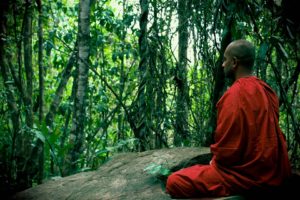It’s 4.35 in the morning. Not a time of day with which I am particularly well acquainted. Outside it’s raining heavily. But I’m indoors, in a large, dimly lit hall with a low ceiling. My eyes are closed and my legs are crossed awkwardly underneath me, slotted in between cushions and blanket. Around me, arranged precisely in rows, 44 similarly positioned men, and beyond them 45 women. In the trees surrounding the hall, nestled in the foothills of the Himalayas in northern India, the birds haven’t started chirping yet. But the room is far from silent. Speakers project a deep groaning; recorded chanting by an elderly man in a language nobody understands.
The noise is irritatingly evocative of the early rounds of X-factor, perhaps a heavily intoxicated Elvis impersonator. And yet, like all of the young, mostly European audience, I fully intend to battle boredom, frustration, pain, and embarrassing smells to remain statuesque for a further two hours, just as on each of the previous 9 mornings. For someone who counts sleeping, fidgeting and letting rip with impunity among his principal vices, this is surely evidence of the Indian spiritual brainwashing so many had warned me about. The cult that finally got me: Vipassana meditation.
My Curiosity for Meditation
And now for the defense (but am I speaking under duress?). 1. I was curious about meditation before coming to India. I had been to some classes in London as an antidote to hectic and stressful corporate rat-race I had entered one day whilst doing something called the ‘milk round’. 2. Vipassana is not a (very) religious thing, it’s a technique of meditation, open to all (granted, with a sprinkling of Buddhist philosophy and even the ultimate target of Enlightenment, a life free of all negative emotions, for those so inclined).3. They don’t ask for money.
I’d heard talk of people achieving a calmer mind, improved ability to enjoy the present rather than worrying about the future or past and greater concentration and awareness. Add to these rumors of exotic tingling sensations around the nipple area and I was sold.
Why would I not enroll in the 10-day intensive course to master the basics?
Well, it turned out there are numerous reasons why not; let this be a warning to anyone considering following in my (now unhurried, deliberate) footsteps. The course requires 100% compliance with a draconian timetable of practice. You meditate from 4 in the morning until 9 at night (4 at night until 9 in the afternoon for those still on Goan hedonist time), with short breaks for toilet and meals. For 10 whole days (and 2 half days) all talking is forbidden, as is eye contact, writing, books, mobile phones, cameras, exercise, physical contact, and ‘sexual misconduct’. Boys are kept separate from girls except in the hall (where it’s too dark to ascertain gender). If you have a serious issue you can speak to the instructor at set times, but otherwise, it’s just you, yourself, yours truly, your mind, the occasional gurgle from a withering Burmese bloke and some pre-recorded instructions.

Some advice for anyone sufficiently unhinged to consider giving it a go:
(please note, sporadically attended monthly 45 minute classes at Brixton Lido are not sufficient preparation for the cerebral marathon that lies ahead)
4.00.- 4.30. Wake up call. vigorously suppress all questions to self about why you are doing this. If raining, do not hear the rain.
4.30 – 6.30. Morning sitting. Place the body in the least comfortable position possible to avoid all dozing. If sleep hits, try not to snore. Make all efforts not to fantasize about porridge and weak tea.
6.30-8 Breakfast. Remain equanimous about the porridge and weak tea. After breakfast is a good time for pooing (except on day 3, strangely). Get 45 minutes shut-eye (essential). Thumping the guy when he rings a bell in your ear at 7.50 will not help to balance your mind.
8-9 Sitting of strong determination. Eyes should be shut for the full hour and all movement is prohibited. Do not fixate on what position to sit in; you will be in agony by the end of the hour regardless.
9-11. Pre-lunch sitting. A good one to let thoughts wander, but be careful, you’ll pay for any cravings. ‘Doing’ all the cricket fielding positions clockwise is good brain food, and the Top Gun script is something of a gold mine. Resist the temptation to assume more positions than Phil Neville in his England career. No, there is no way to get comfortable with one leg in front of you and one leg behind.
11-13. Lunch. Use the first 5 minutes to bend the body back to something resembling straight. Successful recovery of your status as a biped, where possible, makes it easier to get to the canteen. Food is described on the website as ‘healthy and vegetarian’. This is like when your mate’s girlfriend describes her cousin as ‘great company and really pretty, you’ll get on well’. Post-lunch on day 3 is a good time for pooing.
13.14.30 Post lunch sitting. More of you-know-what. The hardest stint due to the full stomach.
14.30-15.30 Sitting of strong determination. Another one of the no-movers. Brace yourself, your knees won’t thank you.
15.30 – 17.00. Early evening sitting. Try not to crave anything. Don’t be despondent when this leads to craving everything.
17-18.00 Evening meal. Yeah right. 2 biscuits and weak tea. The caffeine is your friend though.
18-19.00 Sitting of strong determination. Walk away from this one and you’re almost done for the day.
19.00 – 20.30 Discourse. The day’s undoubted highlight. A video of some bloke’s head explaining the technique – in the context a veritable audiovisual spectacular.
20.30 – 21.00. Final sitting. A nightcap to the round of the day’s binge.
21.00 21.30. Instructor questions. Sign up in advance, you’ll get 2 minutes max. typical dialogue:
“I’m frustrated, It’s not working for me, and the chanting annoys me”.
Broad smile “don’t be worrying. Keep up the trying. The chanting is there to make us feel nice”.
Blank expression.
Head wobble.
“O.k. thanks”
Understandably, for the first few days, I was plagued by confusion and regret at having inflicted this situation on myself. I’d come to India to escape the corporate grindstone and here I was doing an 80 hour week, sitting in the same place for hours on end with people telling me not only what to do but what to think, all for the promise of immeasurable rewards. It felt uncomfortably familiar.
2 days before I was on holiday, now I was torturing myself 17 hours a day, the only discernable rewards a squeaky dorm bed and cold chapatis. Yet I managed to convince myself that leaving would represent catastrophic failure. The course was reduced in my mind to a game of survival. I would not be like the fat bloke at the front who walked out cackling with demonic laughter or the troubled looking pale guy who scarpered amid rumors of a row with the chef. I’d do whatever it took, whilst playing by the rules, to get to the end.
One of the hardest aspects was the simplicity of the technique, the scarcity of ideas or theory.
The basic aim is to enhance your mind’s sensitivity and strength of perception by first focusing on the breath (3 days) and then on innocuous sensations that you feel on all parts of the body (7 days). After some time, you can appreciate how certain thoughts lead to particular sensations, which in turn cause further thoughts. Repeatedly experiencing this cycle, thoughts – feelings – thoughts, at the initial stages eventually help you work out how to stem the tide. By training the mind not to react to these feelings or sensations, the onset of strong emotional states can be prevented, resulting in a more balanced and content outlook.
 Thus the intense exhilaration of reaching lunch on the first day was replaced by a stoic appreciation on day 7, while the deep sorrow felt at the passing of the tomato rice on day 2 turned into a dispassionate acceptance by day 8. Such adjustments made life increasingly bearable. And, we were told, with years of diligent practice we may eventually, like Buddha, reach full enlightenment; a state of constant deep uninterrupted happiness. Like a pig in an eternal cesspit.
Thus the intense exhilaration of reaching lunch on the first day was replaced by a stoic appreciation on day 7, while the deep sorrow felt at the passing of the tomato rice on day 2 turned into a dispassionate acceptance by day 8. Such adjustments made life increasingly bearable. And, we were told, with years of diligent practice we may eventually, like Buddha, reach full enlightenment; a state of constant deep uninterrupted happiness. Like a pig in an eternal cesspit.
Understanding of impermanence
A key weapon in training yourself not to react to sensations is the understanding of impermanence. The idea is constantly drummed home; nothing lasts, all things arise and pass. Successful inculcation of this message can certainly take the edge off some of life’s darker moments, like the downer the day after the end of the football season or the day Helen Daniels left Neighbours. Your sore knees won’t be sore forever so why worry about them now.
There’s nothing particularly revolutionary about these ideas – most people would accept them as largely rational. But understanding them is a far cry from controlling their effects. That’s where 100 hours of meditation comes in – it’s only by investigating and experiencing the process that prevention becomes possible. So they said.
And low and behold, after a few days of intense concentration I started not only to understand but also to feel explanations for many of life’s great mysteries. Like how a kettle can be prevented from boiling simply by continued observation. Or why it’s harder to start a conversation with the hot barmaid in front than the fat bird-eating pork scratchings to your right. Or why thinking of Anne Widdecombe sucking lemons has only a patchy record when it comes to improving sexual performance.
The strict rules to follow
The combination of strict rules and the relative paucity of external stimulus has the effect of sharpening the senses, with some pleasing consequences. Without such heightened visual awareness, I would never have been a party to a masterclass of primates mutual grooming, nor puzzled at the daily routine of ladybirds nor confirmed my long-held suspicions that moths are the animal kingdom’s stupidest member. Similarly, with better hearing than Stevie Wonder I was able to follow conversations between finches about the weather, and even tell which member of my dormitory was urinating in the bathroom in the dead of night.
Unfortunately, nobody’s hearing was good enough to hear the curly-haired Indian from dorm C, locked in the shower room, patiently tapping at the door determined not to break the rules. We learned at the end that he’d emerged, perfectly calm, and bone dry, after an hour and a half meditating naked on the toilet, when the cleaner went in.
Many things got easier with time and force of habit, but after days going cold turkey on the wrong sort of thoughts, biology dictated that certain thoughts entered the consciousness with a particular frequency. The two monkeys romping like John Holmes and Linda Lovelace on the roof of the toilet block on day 6 didn’t help. Yet ultimately, with concerted effort (100% mental. Honest) I was able to resist even these most basal of urges.
By day 7 or so I’d learned largely to avoid thinking about stuff that would increase frustration, but, even so, it was hard by day 9 not to get a little excited about getting back to real life. I spent a whole afternoon session considering my first words and debated whether I’d rather know the champions league scores from last Tuesday or the number of swine flu deaths in the south of England.
Yet, in the event, my ill-disciplined anticipation didn’t come close to preparing me for the surge of emotion, sensations and thoughts that engulfed me when, after one final particularly focused hour sitting the silence came to an end on day 10. I expected sheer elation at having the stuff to say and being able to say it, but what I felt was an intense but profound, controlled contentment, and a warm sense of achievement at having completed something that had been at times bloody hard.
Of course, the resumption of normal linguistic activity brought a few surprises. Sharing a confined space with 44 complete strangers is an oddly intimate experience, even without communication. So there was a little re-adjustment required in accepting that the tall muscular German personal trainer who slept opposite me was, in fact, a squeaky writer from California with a lisp. And the Israeli who had sat three feet ahead of me 10 hours a day for 10 days was in fact called Gary and was from Shrewsbury.
Enjoying many of the reputed benefits
In the days since the course, brainwashed or not, I have perceived myself to be enjoying many of the reputed benefits. Whether I’ll still require a little help from Anne Widdecombe at crucial moments in the future remains to be seen, but I can say for certain that I’m calmer in the face of Indian rickshaw drivers and less fearful of exotic-looking spiders. And I’m absolutely convinced that expending a little effort adjusting how we look at the world is more worthwhile than persisting with trying to mold it to our satisfaction (an impossible task?)
Buddha, or at least some chap writing down his ideas thousands of years later, using a little adage. Think of life as a walk down a long path, littered with thorns and pebbles. People spend the whole time attempting to dodge the thorns and avoid the pebbles. But why not just put some shoes on?
Now, fully Enlightened or not, I don’t agree entirely with him on this. 80 years of walking down a path in comfortable shoes seem like quite a boring existence to me, and with shoes on you’re less likely to notice the fiver on the ground that the guy in front has dropped. But I’m slowly learning that a mix of external challenges and the occasional internal MOT may well be the best approach. So that, after a few miles of happily dodging thorns and pebbles, when a family of hedgehogs crosses the path (the oldest child juggling sea urchins and the grandma carrying an upturned plug socket on her back), you can take out some boots from your backpack, slip them on and carry on down the road.
I guess we’re going down the path like it or not, so it makes sense to do it as comfortably as possible. And who knows, with the odd trip to India to observe the air going in and out of your nose, you may find it leads to your very own eternal cesspit.





